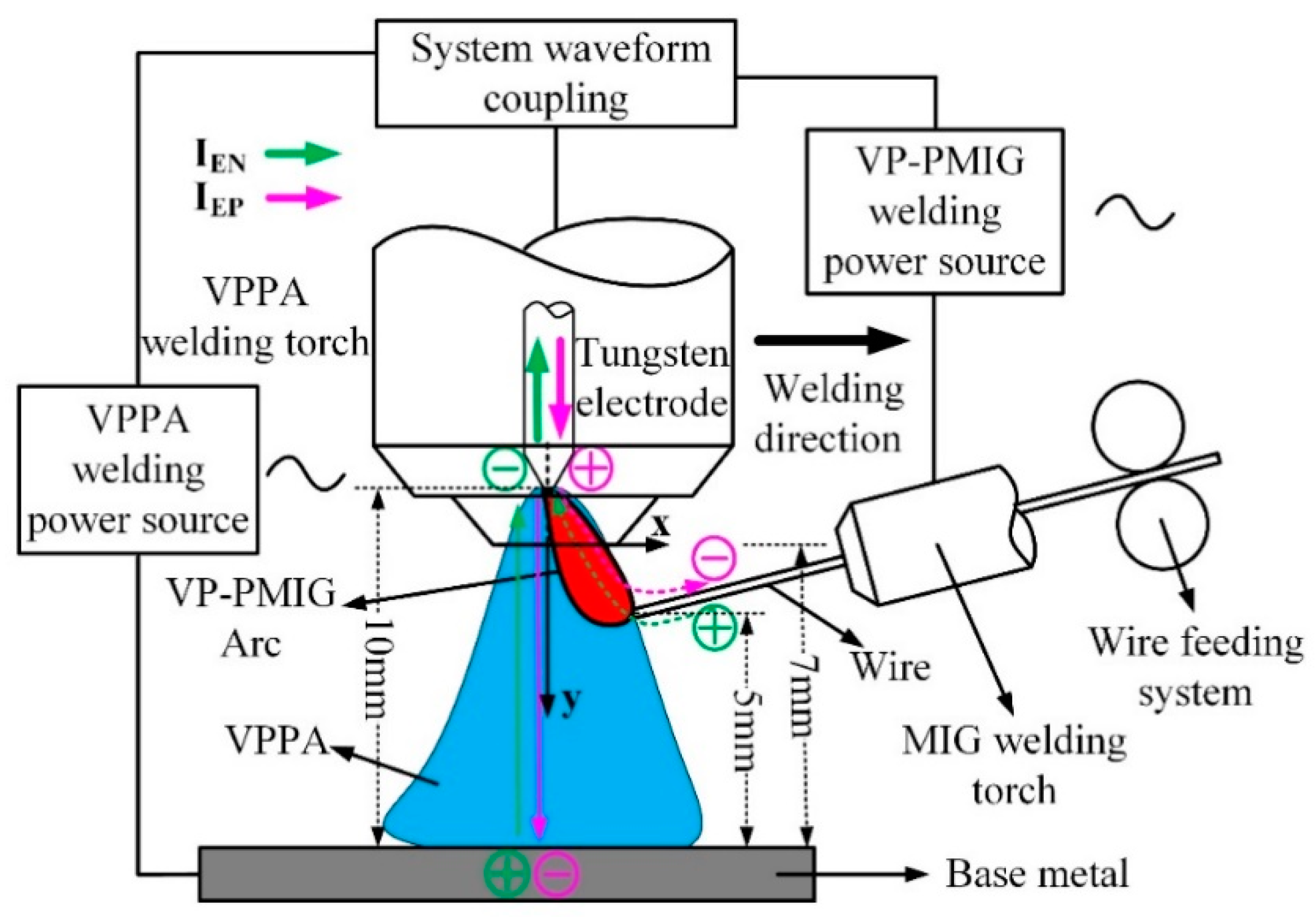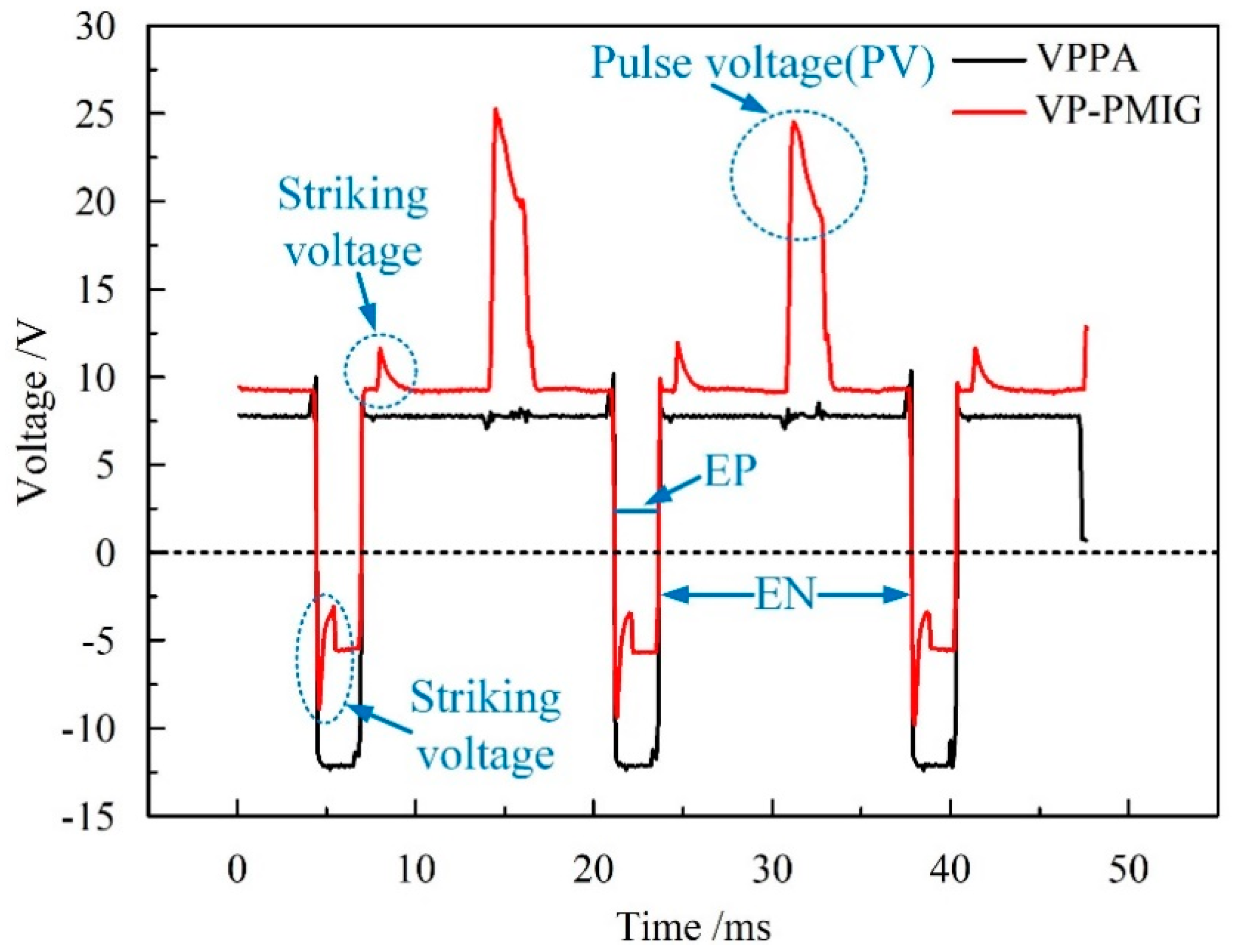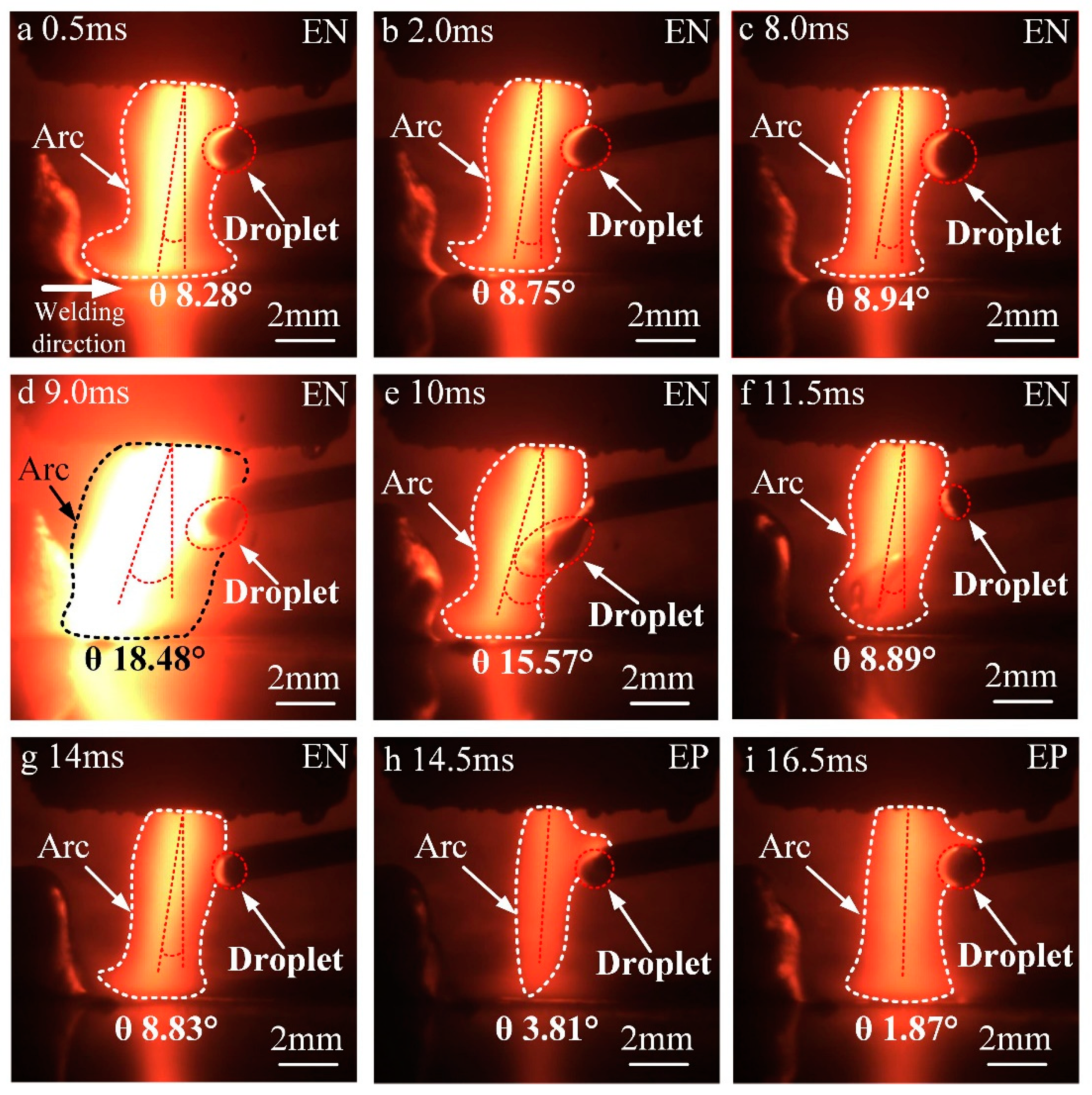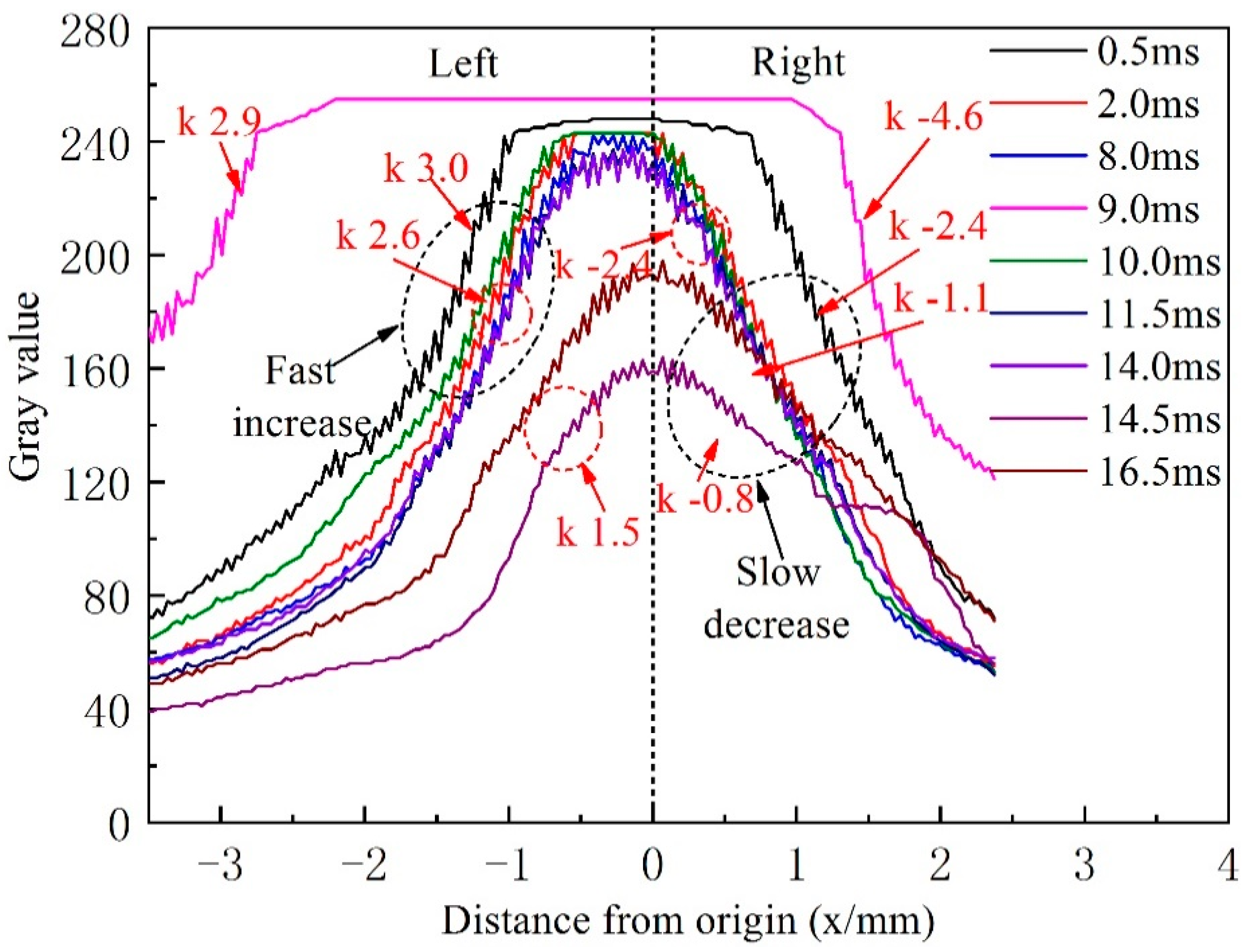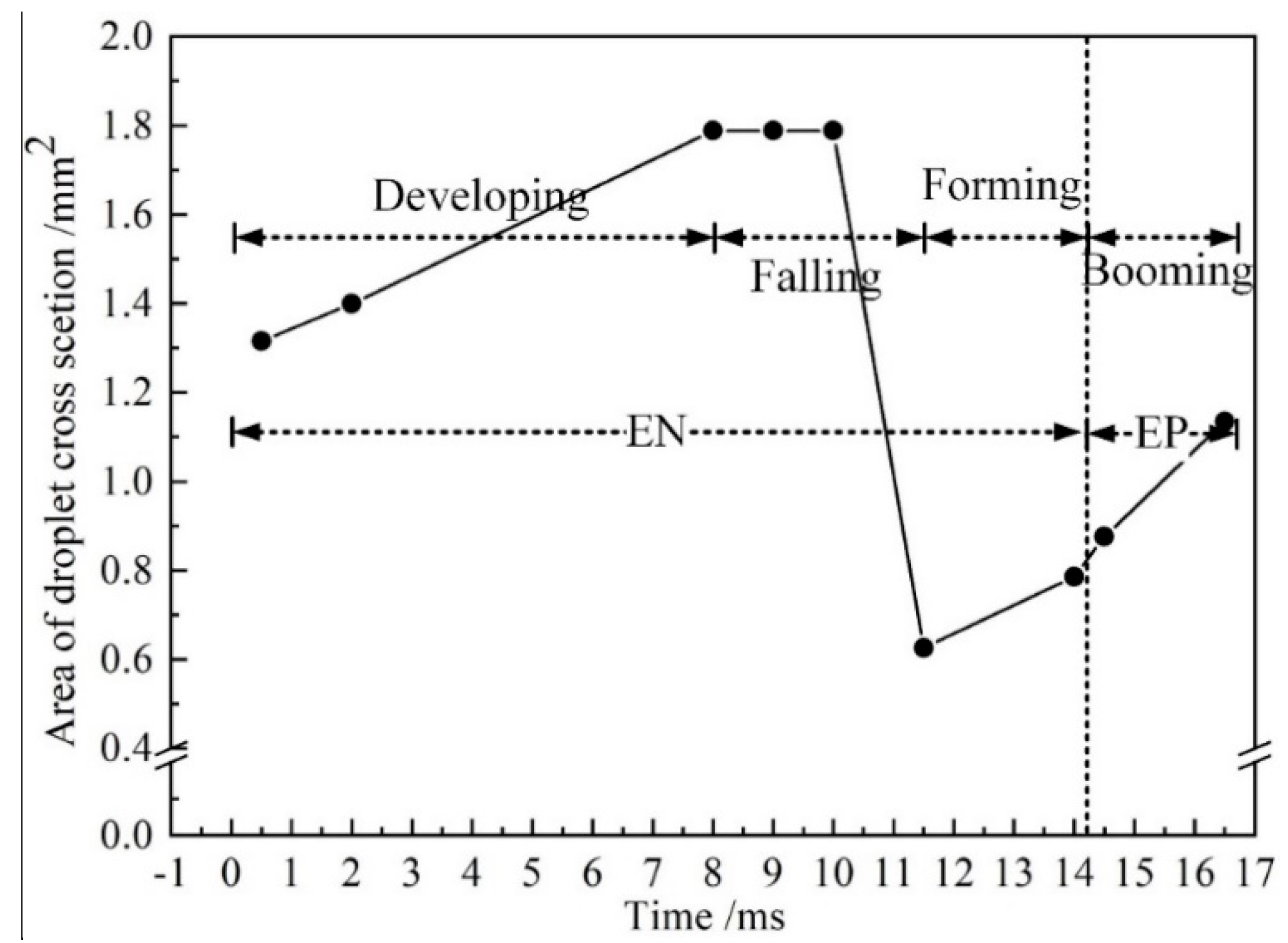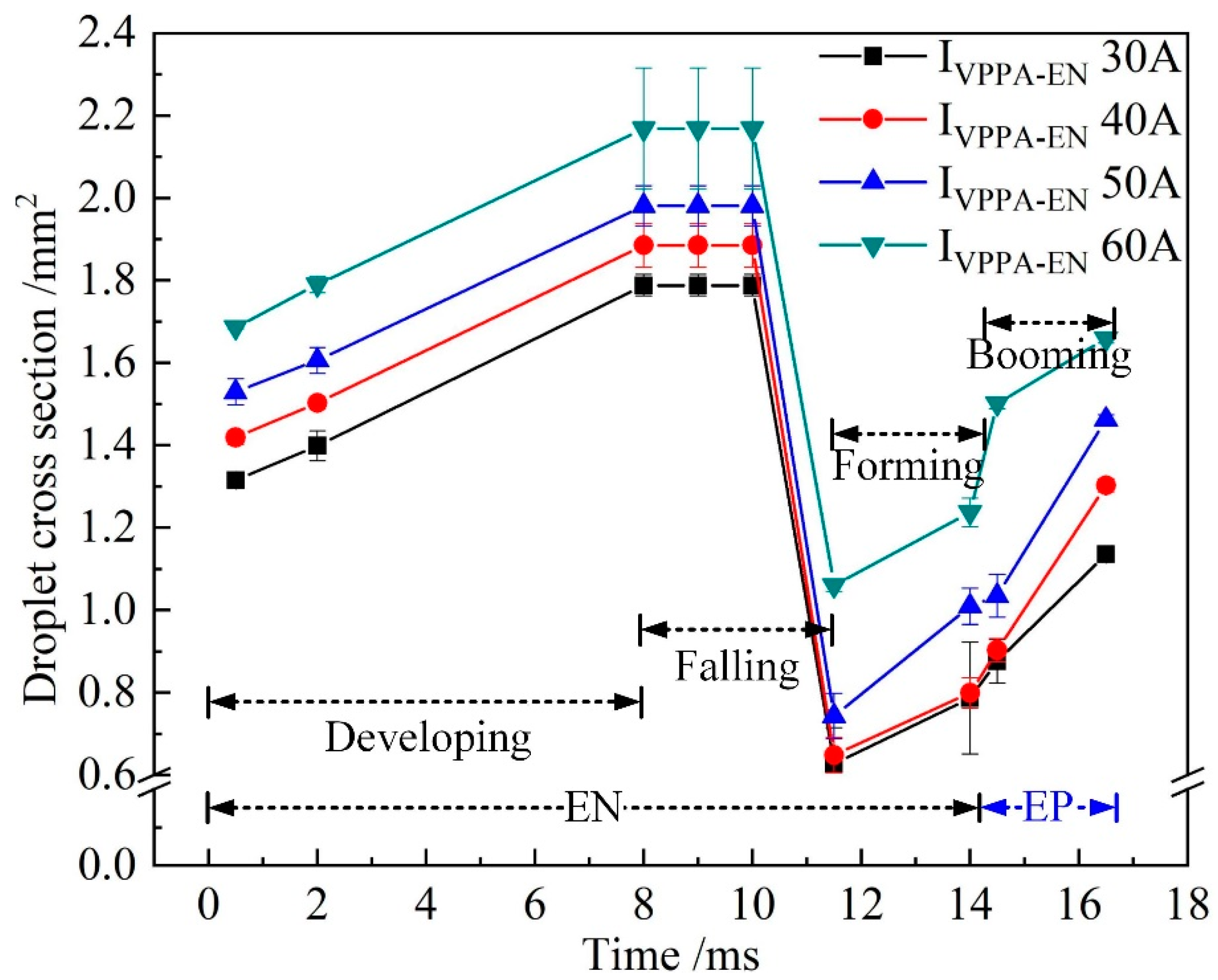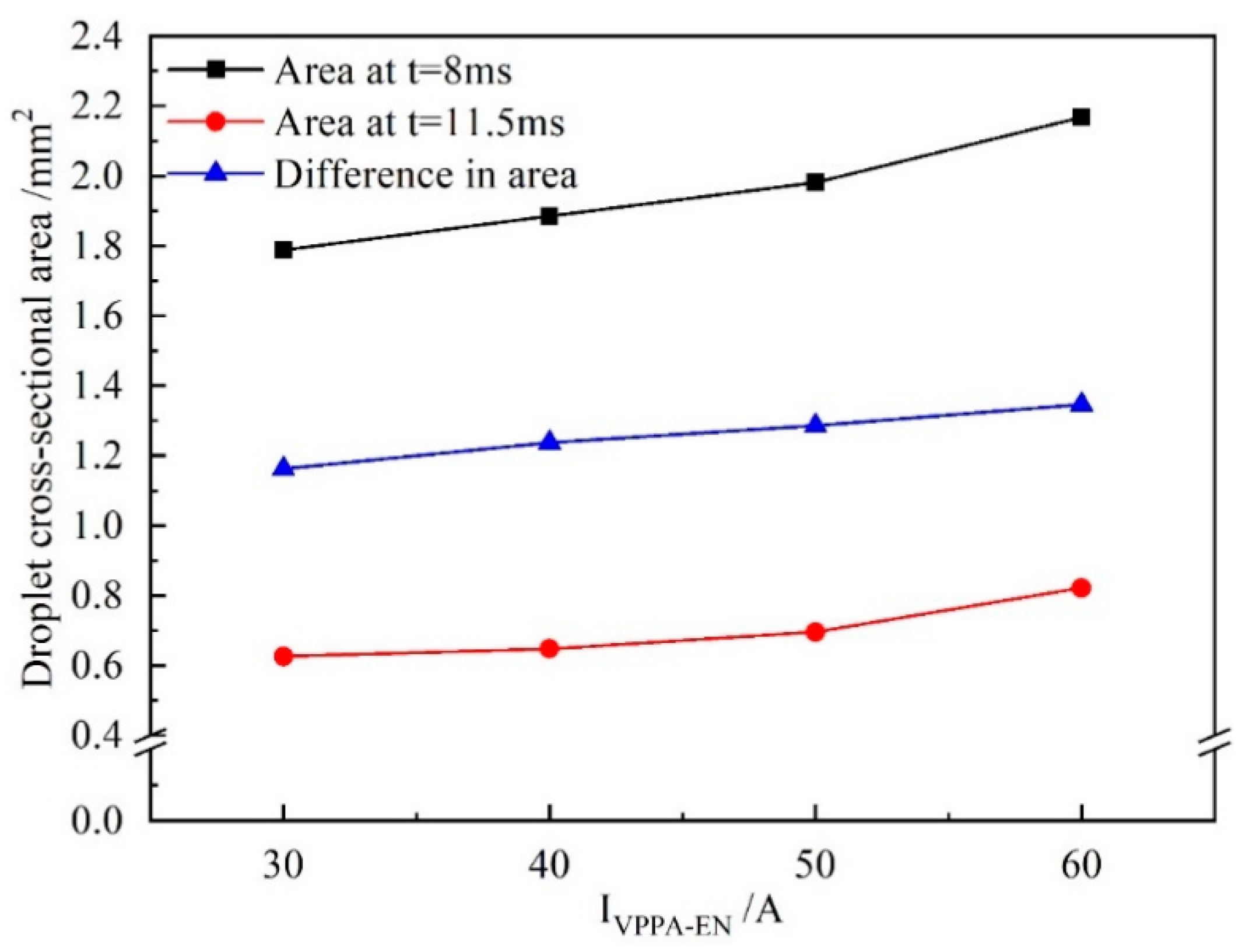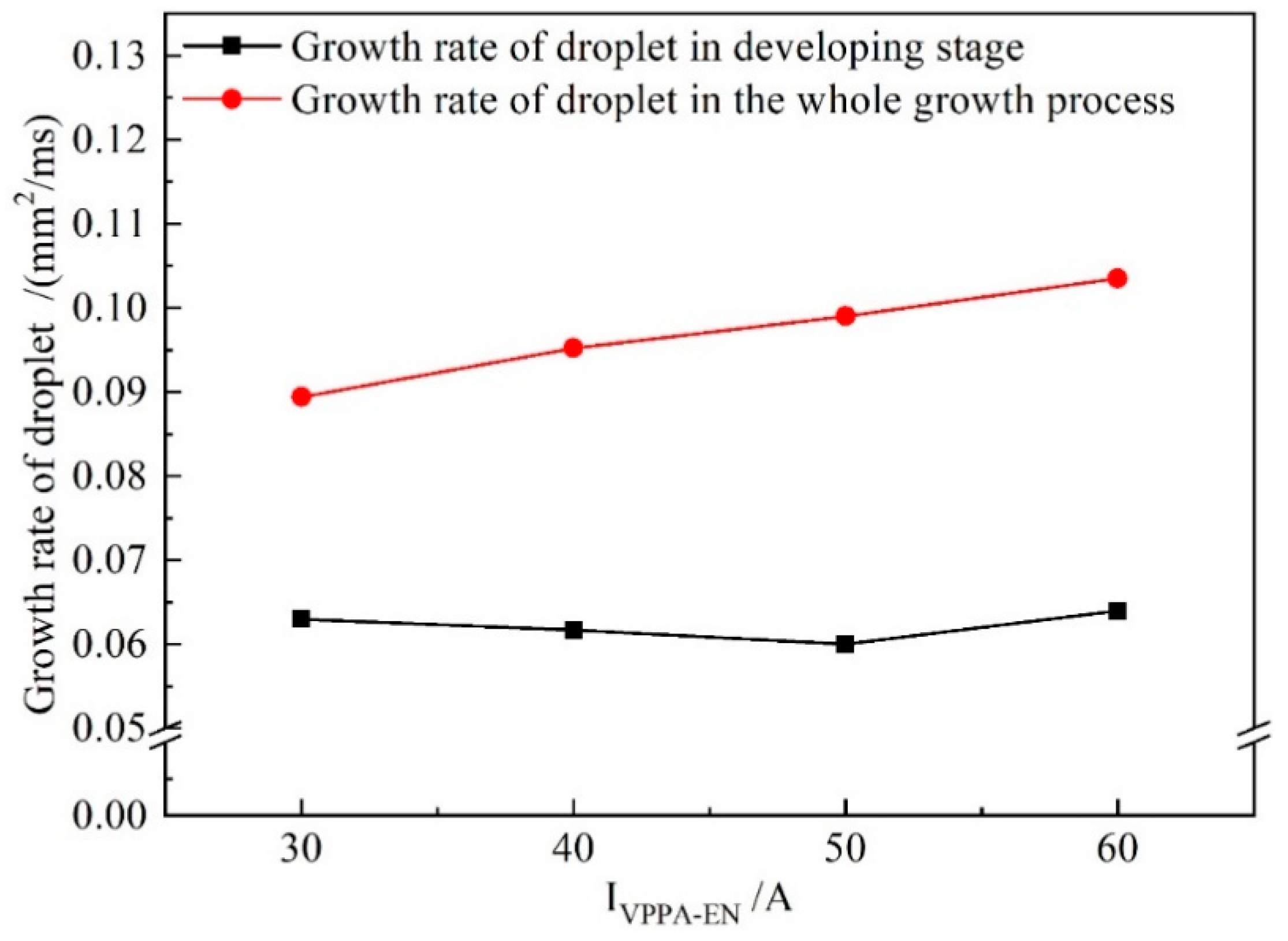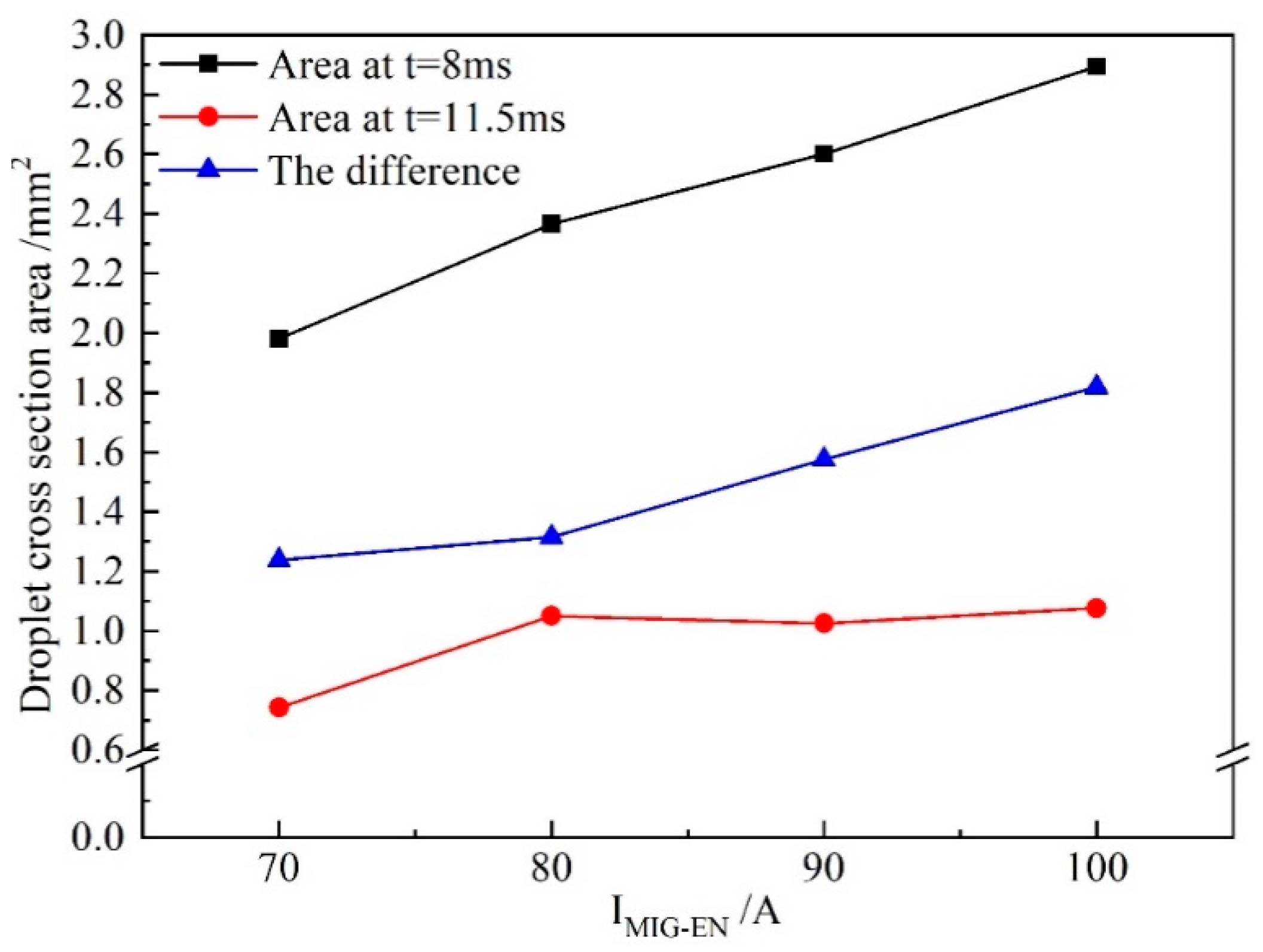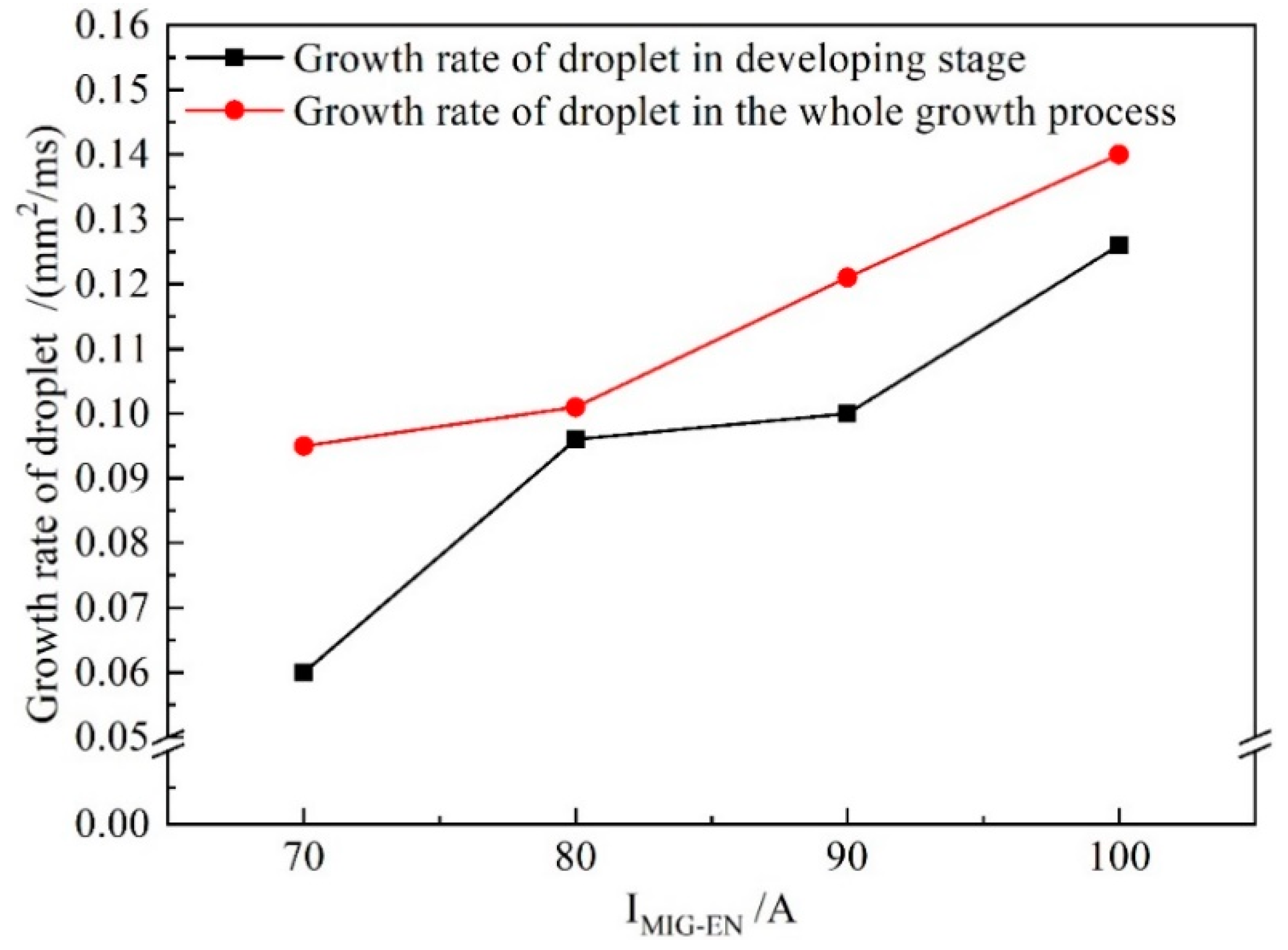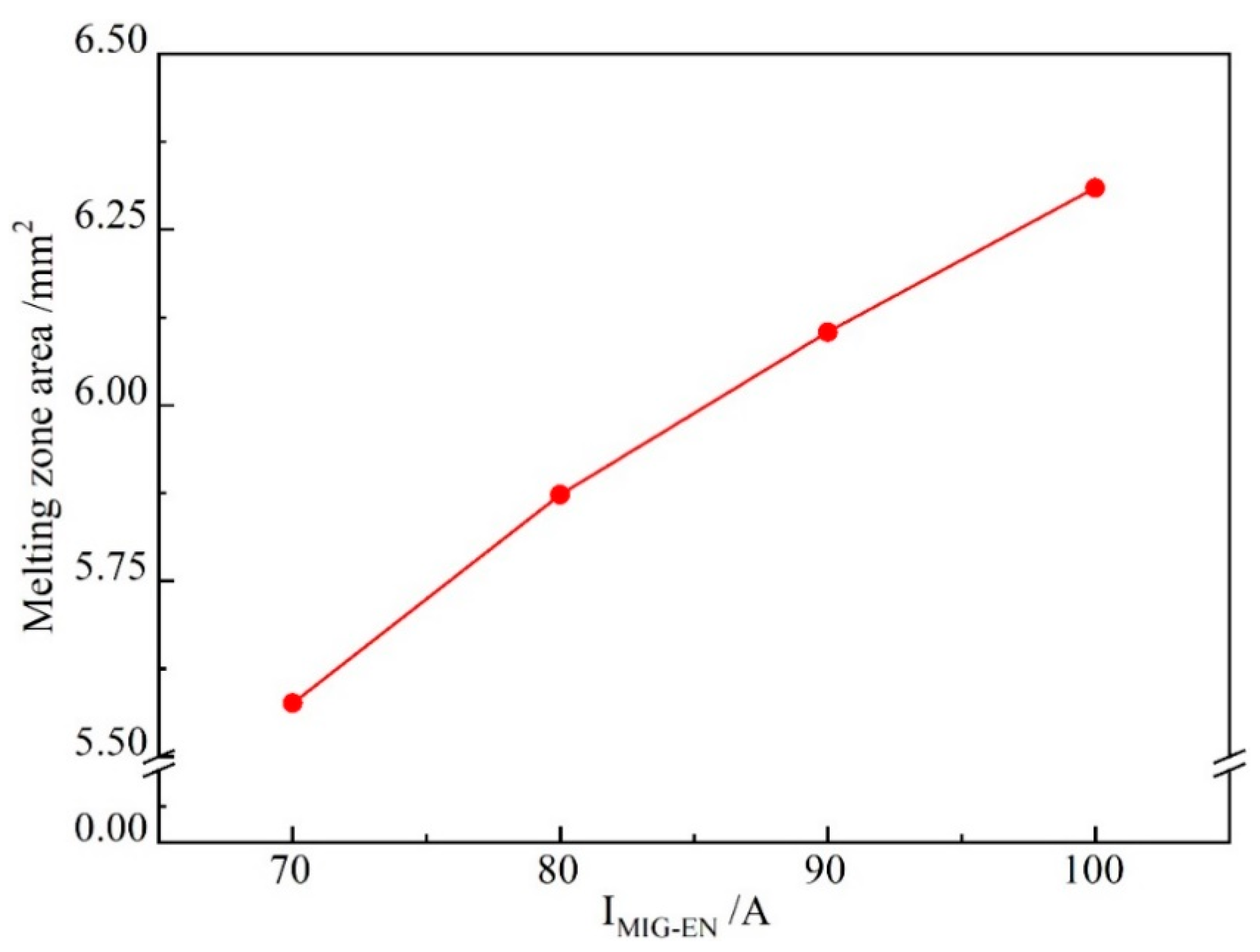3.1. Evolution of Hybrid Arc and Droplet Transfer
Figure 3 shows the evolution of the hybrid arc and droplet transfer during one complete EN–EP phase. Compared with conventional VPPA, the width of the hybrid arc between the nozzle and welding wire is larger. In the EN phase, the shape of the hybrid arc looks like a gourd, while that of conventional VPPA looks like a bell. The VPPA current flows from the base metal to the tungsten electrode, and the VP-PMIG current flows from the wire to the tungsten electrode. Therefore, between the wire and the base metal, the arc shape is similar to that of conventional VPPA. Meanwhile, between the nozzle and the wire, the range of electronic motion is larger, resulting in a wider arc. The cathode spot is attracted to the superficial oxide of the wire because of its decreased work function. Hence, in the EP phase, the VP-PMIG arc at the end of the wire is more obvious, and the arc tends to climb up along the wire, as shown in
Figure 3h,i.
In order to study the effect of droplet transfer on the shape of the hybrid arc, we define the angle between the arc axis and a surface normal extending from the base metal to the center of the tungsten tip as the arc deflection angle
θ shown in
Figure 3. From 0.5 to 8.0 ms, the value of
θ increases gradually. The distance between the upper surface of the droplet and the central axis of the hybrid arc decreases with droplet growth. Therefore, the VP-PMIG arc gradually becomes closer to the VPPA. As both currents are flowing in the same direction they repel each other, the hybrid arc deflects along the negative
x-axis. In
Figure 3d, the value of
θ surges to 18.48°, the maximum, and at that moment the VP-PMIG current reaches 380 A, the repulsive force between the currents increasing sharply. Therefore, the deflection angle of the hybrid arc increases greatly. In
Figure 3e, the deflection angle of the hybrid arc decreases to 15.57° at 10 ms, and the main body of the droplet has entered the VPPA completely. The pulse current drops to zero and the VP-PMIG current returns to 70 A. In the next frame, the droplet falls off and the end of the welding wire melts again, as shown in
Figure 3f. The VP-PMIG arc is separated from the VPPA, and the deflection angle of the hybrid arc decreases to the initial level. In the EP phase, the VP-PMIG arc climbs up along the wire, and the hybrid arc is deflected towards the
y-axis due to the mutual attraction between currents.
The brightness of the hybrid arc is determined by the current density, which is positively related to the temperature of the hybrid arc. Therefore, the brightness distribution of the hybrid arc can be considered indicative of its temperature distribution.
Figure 4 shows a gray-scale image corresponding to the image captured by the high-speed camera at 0.5 ms. In
Figure 4, a coordinate system is established in which the intersection of the tungsten axis and the nozzle end face is the origin. The width of the hybrid arc is largest near
y = 1 mm, where the effect of arc coupling is optimal. Therefore, the temperature distribution along
y = 1 mm can reflect the temperature distribution characteristics of the hybrid arc.
Figure 5 shows the distribution of gray values along the dashed red line,
y = 1.0, at different times, corresponding to
Figure 3. At 0.5 ms, the curve assumes a maximum value at
x = −0.2 mm and changes little between −1.2 and 0.7 mm. This is because the current density of the hybrid arc increases due to the striking current, resulting in an increased temperature of the central area of the arc. When
x < −1.2 mm, the curve slope is 3.0, whereas, when
x > 0.7 mm, the curve slope is −2.4, thus, the temperature distribution along the horizontal line of the hybrid arc is asymmetric. On the right of the hybrid arc center, the temperature of the arc declines more slowly, because of the VP-PMIG arc and the associated increased current density. At 2.0 ms, the striking voltage drops to zero, resulting in the energy of VP-PMIG arc decreasing. Therefore, the high temperature area on the right side of the hybrid arc decreases. However, the rate of change of temperature on the right of the hybrid arc is still lower than that on the left. Because the voltage does not change, the curves at 8.0, 10.0, and 11.5 ms are similar to that at 2.0 ms. At 9.0 ms, however, the gray value reaches the maximum value between −2.2 and 1.0 mm and remains constant, because the pulse current causes the current density of the hybrid arc to increase rapidly. Furthermore, the temperature decline rate on the right of the hybrid arc is now greater than that on the left, and is attributed to the deflection of the hybrid arc.
The absolute values of the slope on the right side of the curves of the EP phase are much lower than those of the EN phase. Firstly, VPPA actively seeks oxide on the base metal in the EP phase so that the arc expands. Hence, the current density decreases, and the temperature of the arc center decreases. Secondly, the VP-PMIG arc climbs up along the wire in the EP stage, which leads to an increase of the area of the hybrid arc on the right of the distribution.
Figure 6 shows the evolution of the area of the droplet cross section with time. From 0.5 to 2.0 ms, the droplet cross-sectional area increases from 1.3 to 1.4 mm
2, with a growth rate of 0.067 mm
2/ms. From 2.0 to 8.0 ms, the droplet cross-sectional area increases from 1.4 to 1.8 mm
2, with a rate of 0.065 mm
2/ms. Thus, as the droplet grows steadily between 0 and 8.0 ms, this stage is referred to as the developing stage. From 8.0 to 11.5 ms, the droplet necks and falls off, which is referred to as the falling stage.
Figure 7 shows a force analysis on the anode droplet during the falling stage. The droplet is mainly affected by the gravity (
), the resultant force of surface tension (
), and the electromagnetic force (
). The direction of
is along the
y-axis, which is conducive to drop fall off. The direction of
is perpendicular to the axis of the wire, and it is beneficial to necking of the droplet. The direction of
is perpendicular to the root of the droplet, and it hinders the transfer of the droplet. The value of
is positively related to the cross-sectional area of the droplet root.
In
Figure 7a,
is in balance with
, resulting in the droplet not being detached from the end of the wire. In
Figure 7b, the VP-PMIG arc current (
) is 380 A at 9.0 ms, which is 5.4 times that at 8.0 ms. Due to the fact that
is proportional to the square of the current, its value has been increased approximately 28-fold. This sudden increase of
causes the droplet to neck near the end of the wire. Since the cross-sectional area of the droplet origin decreases, the surface tension decreases, and
drives the droplet away from the end of the wire. In
Figure 7c, necking of the droplet is intensified due to
, and as shown in
Figure 7d, the droplet falls into the pool, and the wire starts to melt to form a new droplet.
From 11.5 to 14 ms, the cross-sectional area of the droplet increases from 0.62 to 0.78 mm2, and the growth rate is 0.064 mm2/ms. During this period, the amount of molten metal at the end of the wire is small and the droplet grows steadily. Therefore, the stage between 11.5 and 14 ms is defined as the forming stage. From 14 to 14.5 ms, the cross-sectional area of the droplet increases from 0.79 to 0.88 mm2, and the change rate is 0.18 mm2/ms, which is 2.8 times of that in the falling stage. During this period, Ohmic heats at the end of wire, due to the striking voltage. Additionally, the melting point of the wire is low (melting range 574–632 °C), so that the cathode wire mainly emits electrons through field emission. Due to the fact that the cathode voltage is higher than the anode voltage, the power is increased. Therefore, the rate of wire melting is higher in the EP phase. Meanwhile, from 14.5 to 16.5 ms, the cross-sectional area of the droplet increases from 0.88 to 1.14 mm2 with a growth rate of 0.13 mm2/ms. The growth rate of the cross-sectional area of the droplet in EP stage is much higher than that in the development and forming stages, and thus, this stage is defined as the booming stage.
Droplet growth mainly occurs in the forming, booming, and developing stages, with incremental increases in the cross-sectional area of 0.24, 0.26, and 0.65 mm2 respectively. In the EN stage, the incremental increase of the cross-sectional area of the droplet accounts for 77.53% of the total increment. Therefore, it is considered that the currents in the EN stage dominate mass transfer.
3.2. Influence of VPPA and VP-PMIG Arc Current on Mass Transfer
Figure 8 shows the evolution of the droplet cross-sectional area when
IVPPA-EN is varied and
IMIG-EN is fixed at 70 A. With increasing
IVPPA-EN, the droplet cross-sectional area of each stage increases, indicating that the VPPA current has a certain effect on wire melting. At 8.0 ms, the cross section area of the droplet can reflect the size of droplet before falling off. At 11.5 ms, the cross section area of the droplet can reflect the size of the droplet after falling off. Therefore, the mass transfer can be indirectly reflected by the difference of the droplet cross section area between 8 and 11.5ms.
Figure 9 shows the difference in the droplet cross-sectional area between 8 and 11.5 ms when
IVPPA-EN is varied. When
IVPPA-EN is 30 A, the cross-sectional area of the droplet at 8 and 11.5 ms are 1.79 and 0.63 mm
2, respectively, and the difference is 1.16 mm
2. When
IVPPA-EN is 60 A, the difference increases to 1.35 mm
2. Therefore, the rate of change of the droplet cross-sectional area with increasing
IVPPA-EN is 0.006 mm
2/A.
Figure 10 shows the growth rate of the droplet cross-sectional area for increasing
IVPPA-EN during the developing stage and the whole growth process (forming, booming and developing). When
IVPPA increases from 30 to 60 A, the growth rate of the droplet cross-sectional area in the developing stage is almost unchanged. Meanwhile, the growth rate of the droplet in the whole growth process increases with increasing VPPA current. Thus, the VPPA current has little effect on the growth rate of the droplet during the development stage. Due to the fact that the welding parameters of the forming stage are the same as those of the developing stage, the VPPA current also has little effect on the growth rate of the forming stage. Therefore, when the VPPA current increases, the effect of the VPPA on the mass transfer mainly occurs in the EP stage. It is considered that the heat absorbed by the wire to melt comes from two sources. Heating from the VP-PMIG arc established between the tungsten electrode and wire will play an important role in melting the wire. Furthermore, energy from the VPPA will heat the wire end when it enters into the VPPA.
IVPPA-EP is 30 A higher than
IVPPA-EN, so the effect of VPPA on wire melting in the EP phase is more obvious.
Figure 11 shows the evolution of the droplet cross-sectional area when
IMIG-EN is changed and
IVPPA-EN is maintained at 50 A. With the increase of
IMIG-EN, the growth rate of the droplet cross-sectional area during the developing stage increases, and the increment of the droplet cross-sectional area at 8.0 ms also increases. This shows that increasing the VP-PMIG current is more conducive to wire melting than increasing the VPPA current.
Figure 12 shows the difference in the droplet cross-sectional area at 8 and 11.5 ms with
IMIG-EN changing. When
IMIG-EN is 70 A, the cross-sectional areas of the droplet at 8 and 11.5 ms are 1.98 and 0.74 mm
2 respectively, and the difference is 1.24 mm
2. When
IMIG-EN is 100 A, the cross-sectional areas at 8 and 11.5 ms are 2.9 and 1.1 mm
2 respectively, and the difference is 1.8 mm
2. Therefore, the rate of change of the droplet cross-sectional area with
IMIG-EN increasing is 0.019 mm
2/A, which is 3.17 times that with
IVPPA-EN increasing. This indicates that the VPPA and VP-PMIG arc currents influence the mass transfer by 24% and 76%, respectively.
Figure 13 shows the growth rate of the droplet cross-sectional area with
IMIG-EN increasing in the developing stage and the whole growth process. In
Figure 13, the growth rate of the droplet in the development stage obviously increases with increasing current. Meanwhile, when
IMIG-EN exceeds 80 A, the growth rate of the droplet in the developing stage reaches 82% of that in the whole process. Therefore, the effect of the VP-PMIG arc current on the melting wire in the EN phase is more obvious.
3.3. Influence of VPPA and VP-PMIG Arc Current on Heat Transfer
Figure 14 shows the weld shape and melting area of the base metal when
IVPPA-EN is varied and
IMIG-EN is maintained at 70 A. In
Figure 14a, the melting area is 3.0 mm
2. In
Figure 14d, the melting area is 6.3 mm
2. When
IVPPA-EN is increased from 30 to 60 A, the melting area of the base metal increases by 3.3 mm
2, and the average increase rate is 0.11 mm
2/A.
Figure 15 directly shows the trend of the change of melting area with
IVPPA-EN.
In
Figure 15, with increasing
IVPPA-EN, the rate of increase of the melting area of the base metal decreases. When
IVPPA-EN increases from 30 to 40 A, the melting area increases from 3.0 to 4.4 mm
2. The melting area of the base metal increases with
IVPPA-EN at a rate of 0.14 mm
2/A. Then, when
IVPPA-EN increases from 40 to 50 A, the melting area increases from 4.4 to 5.6 mm
2, and the corresponding increase rate is 0.12 mm
2/A. When
IVPPA-EN increases from 50 to 60 A, the melting area increases by 0.7 mm
2, and the corresponding growth rate is 0.07 mm
2/A. It is found that the maximum value of the increase rate is twice the minimum value. On the one hand, the increase of
IVPPA-EN will increase the heat input to the base metal, so the melting area will increase to a certain extent. On the other hand, the thermal conductivity of the aluminum alloy is very high, thus with increased heat input, heat conduction loss also increases correspondingly.
Figure 16 shows the weld shape and melting area of the base metal when
IMIG-EN is varied and
IVPPA-EN = 50 A. In
Figure 16a, the melting area is 5.6 mm
2. In
Figure 16d, the melting area is 6.3 mm
2. When the
IMIG-EN increases from 70 to 100 A, the melting area of the base metal increases by 0.7 mm
2.
Figure 17 directly shows the trend of change of the melting area with
IMIG-EN.
In
Figure 17, when
IMIG-EN increases from 70 to 80 A, the melting area increases from 5.6 to 5.9 mm
2. The melting area of the base metal increases with
IMIG-EN at a rate of 0.03 mm
2/A. Then, when
IMIG-EN increases from 80 to 90 A, the melting area increases from 5.9 to 6.4 mm
2, and the corresponding increase rate is 0.05 mm
2/A. When
IMIG-EN increases from 90 to 100 A, the melting area increases by 0.2 mm
2, and the corresponding increase rate is 0.02 mm
2/A. When
IMIG-EN increases from 70 to 100 A, the average increase rate is 0.023 mm
2/A. Therefore, on average, the contribution of
IVPPA-EN to the heat transfer of base metal melting is about 4.5 times that of
IMIG-EN. This indicates that the VPPA and VP-PMIG currents control the heat transfer by 82% and 18%, respectively.
It is considered that the VPPA is established between the tungsten electrode and the base metal. The heat sources of the VPPA to the base metal include: heat conduction of the VPPA to the base metal and Ohmic heating generated by the VPPA current flowing through the base metal. In addition, in the EN stage, the base metal is heated by electron condensation. In the EP stage, the base metal is heated by ion recombination. However, the VP-PMIG arc is between the tungsten electrode and wire. The thermal effect of the VP-PMIG arc on the base metal is limited to heat conduction. Therefore, VPPA plays a leading role in the heat transfer of the base metal.
